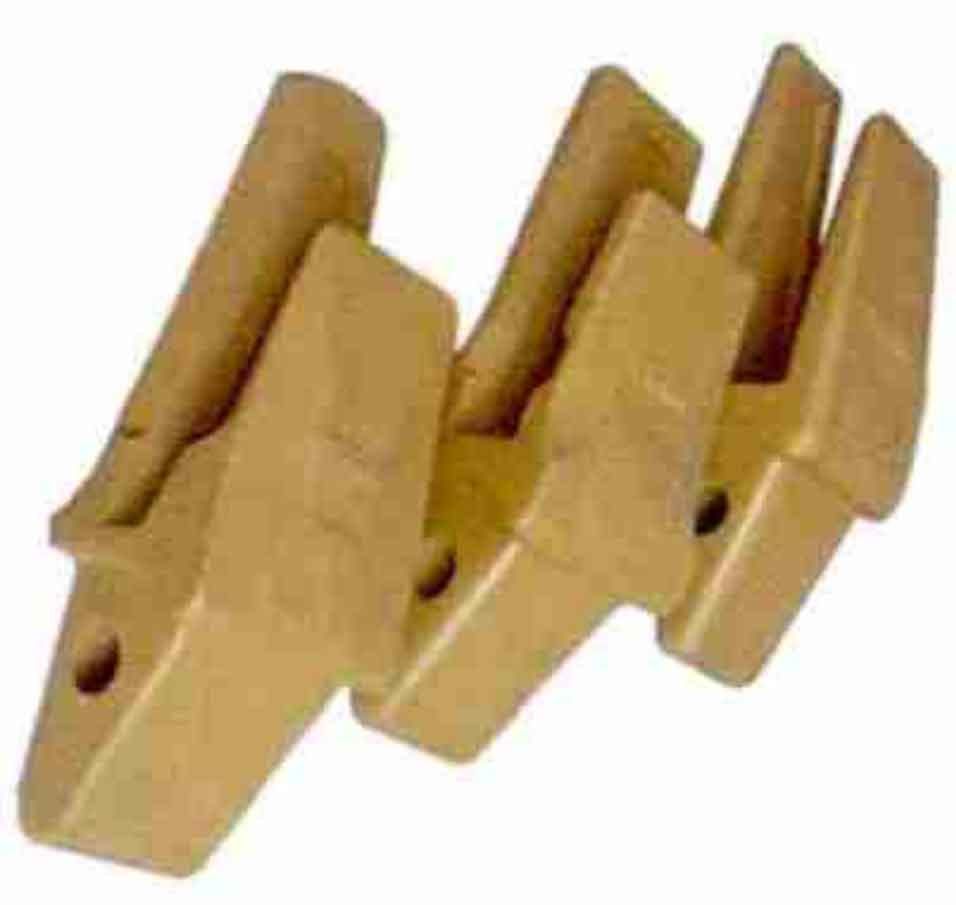Infrastructure development remains a crucial pillar of domestic economic growth, driving increasingly stringent requirements for equipment manufacturing. The bucket tooth, a critical wear component in excavation machinery, features complex geometry with drastic sectional variations. Traditional casting methods often yield products with porosity, inadequate wear resistance, and poor toughness, directly impacting operational efficiency and costs. Recent advancements in automated roll forging technology have enabled innovative forging approaches. This research introduces a precision roll forging-preform combined with integral die forging process for bucket tooth manufacturing, significantly enhancing product performance.

The studied bucket tooth (21.5kg mass, 42CrMo steel) exhibits extreme sectional transitions between its pin seat (large cross-section) and tooth tip (small cross-section). Vertical forging is mandatory due to the forged pin hole requirement. Metal flow challenges occur at the tip region during forming, as material naturally flows toward minimal resistance zones. To overcome this, preform design must strategically allocate additional material at critical sections. Our methodology employs precision roll forging on a φ560mm automated mill followed by final forging on a 2500-ton electric screw press.
Process Design and Analysis
Initial preform design preserves the original 100mm diameter bar stock at the upper section while forming the lower cross-shaped geometry through roll forging. The height-to-diameter ratio (2.3) necessitates an intermediate upsetting operation before final forging to enhance stability and material flow. The roll forging pass sequence is determined through extension coefficient calculations:
Total extension coefficient:
$$\lambda_Z = \frac{A_0}{A_N} = \frac{7853\text{mm}^2}{3320\text{mm}^2} = 2.36$$
Number of passes:
$$n = \frac{\log \lambda_Z}{\log \lambda_p} = \frac{\log 2.36}{\log 1.6} \approx 1.82 \rightarrow 3\text{ passes (rounded up)}$$
A three-pass elliptical-elliptical groove system replaces conventional oval-round sequences to accommodate the cross-shaped section and high reduction requirements. Pass sections are reverse-designed using volume constancy principles:
| Pass | Section Type | Key Dimensions (mm) | Area (mm²) |
|---|---|---|---|
| 1 | Modified Ellipse | Height=95, Width=120 | 7853 → 6100 |
| 2 | Ellipse | Height=115, Width=75 | 6100 → 4150 |
| 3 | Cross-shaped | Flange=35, Web=25 | 4150 → 3320 |
Numerical Simulation and Validation
Finite element analysis examined material flow, forming loads, and defect formation. The roll forging model incorporated rotational constraints matching the φ560mm mill’s operational parameters. Simulation results demonstrated:
| Process Stage | Torque/Load | Material Flow Observation | Defect Status |
|---|---|---|---|
| Roll Pass 1 | 80 kN·m | Effective cross-section reduction | No instability |
| Roll Pass 2 | 42 kN·m | Uniform metal distribution | No scraping |
| Roll Pass 3 | 18 kN·m | Near-net-shape formation | Minimal flash |
| Upsetting | 221 tons | Controlled head deformation | No folding |
| Final Forging | 2750 tons | Complete die filling | Uniform flash |
Metal flow patterns during bucket tooth forming revealed critical behaviors:
1. Tip region filling requires precise preform material allocation
2. Upsetting creates optimal flow conditions for pin seat formation
3. Final forging achieves 92% material utilization efficiency
Strain distribution analysis confirmed homogeneous deformation without localized shear bands. The cross-shaped section formed completely without underfill, validating the groove design. Process forces remained within equipment capacity limits throughout all stages.
Technical Advantages of Integrated Process
The precision roll forging-die forging sequence provides distinct benefits for bucket tooth production:
| Parameter | Casting Process | Proposed Forging Process |
|---|---|---|
| Material Utilization | 75-82% | 92% |
| Impact Toughness | 15-25 J | 45-60 J |
| Service Life | 120-150 hrs | 300+ hrs |
| Defect Rate | 8-12% | <1.5% |
The strain-hardening effect during cold die forging significantly enhances surface hardness at critical wear zones. Residual stress analysis showed compressive surface stresses averaging -350 MPa, substantially improving fatigue resistance compared to cast alternatives.
Industrial Implementation
Production trials confirmed the process stability on standard equipment. Key operational parameters:
Roll forging temperature: 1150°C ± 20°C
Die forging temperature: 850°C ± 30°C
Cycle time: 55 seconds per bucket tooth
Tool life: 8000+ pieces per die set
The process enables direct forging of the pin hole, eliminating secondary machining operations. Dimensional accuracy achieved IT10-IT11 tolerances across critical interfaces, satisfying assembly requirements without post-processing.
Conclusion
This research establishes a viable precision roll forging-die forging process for high-performance bucket tooth manufacturing. The three-pass roll forging sequence with elliptical-elliptical groove design effectively distributes material for subsequent vertical forging. Numerical simulation validated complete die filling with 92% material utilization and controlled forming loads within standard equipment capacity. The forged bucket tooth exhibits superior mechanical properties compared to cast alternatives, particularly in wear resistance and impact toughness. This methodology provides a technical foundation for converting cast-to-forged production across similar complex components in construction machinery.
